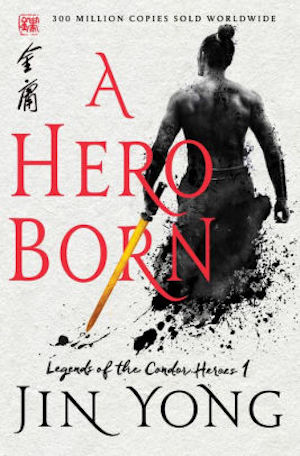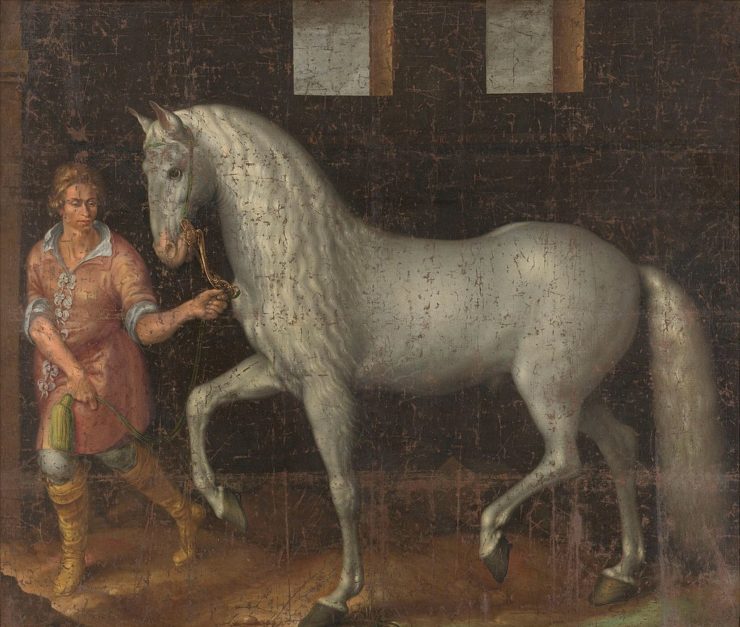In my personal canon, the horses of Spain and Portugal are the “Iberian cousins,” relatives of my Spanish-descended Lipizzans. What the European Warmblood is now, and the Thoroughbred was in the nineteenth and early twentieth centuries, the ancestors of the Andalusian and Lusitano were to the equestrian elite of the Baroque era. When the Hapsburgs set out to create their own imperial horse, they started with horses of Spanish extraction. Later they crossed in other lineages including the Arabian, after war and disease had done severe damage to the Spanish bloodstock.
All the histories of the Andalusian point out that the Iberian Peninsula has been home to horses since the Ice Age, and cave paintings depict and often center them. When or how domesticated horses came into the region is much less well established, but we do know that there were horses in Iberia in Roman times, and that they were much prized. They were apparently convex in the profile: ram-nosed as the Romans said, or as we say now, Roman-nosed. The Romans liked their horses with, shall we say, assertive heads. Not for them the delicate concavity of the Arabian.
When the Moors conquered Spain in the early Middle Ages, they brought their own horses with them, notably the Berber horses of North Africa. These Barbs were crossed extensively on the native Spanish horses. It’s said the celebrated warhorse of El Cid Campeador, Babieca, was one of these; that he came from Andalusia, and he might have been bred by Carthusian monks.
This may be true and it may be legend, because the Carthusians played a significant role much later in preserving certain select lines of Andalusian horses. To this day, Carthusian breeding is one of the most sought after, and horses with these bloodlines fetch premium prices.
By the end of the Middle Ages, the Spanish horse had become the ideal royal and noble mount. This substantial but refined horse with his luxuriant mane and tail was as athletically gifted as he was beautiful. He was the star of the equestrian manège or riding school, as well as the battlefield and the bullfighting arena. His descendants in Austria became the Dancing White Horses of Vienna—grey or white being the favored color of the royal horses, though the original stock came in all colors including pinto and leopard-spotted.
Although the Andalusian has been supplanted in international competitive dressage by the Warmblood, the Spanish team still regularly competes pure Spanish horses all the way to the Olympics, and in Brazil their Portuguese cousins have done the same. Both Spain and Portugal continue their long tradition of classical riding and training, using horses bred for centuries to perform the movements with grace and brio—and to look gorgeous while doing it.
Andalusians are the ultimate fantasy horses in film and television. Shadowfax was played in the movies by an Andalusian. Navarre’s evil opponent in Ladyhawke rides a spectacular grey Andalusian. (Navarre rides a Friesian, which is another of the “romantic” breeds.) Most costume dramas on the past few decades have featured one or more beautiful long-maned, often grey horses with distinctive, high-arched necks, round croups, and low-set tails. Colin Firth’s Mr. Darcy rides what looks like an Andalusian cross in the One True Pride and Prejudice I Accept No Substitutes. Jaime Lannister’s lovely mount in the battle of baggage train versus dragon—Andalusian.
While I’ve given my heart to another of the Spanish Cousins, the one that dances higher and stronger and with notably more attitude, I recognize the true fantasy excellence of the Andalusian. Not just the beauty but the heart and spirit of the breed, its gentleness and fire, and its soft flowing gaits. You can mount an opera singer with zero riding talent or experience on an Andalusian and get him singing an aria, and the horse will passage sweetly onward, giving his all to the cause.
He’s not a Giant Fantasy Monster, mind. He’s mid-sized, between 15 and 16 hands as a rule, with his ladies running slightly smaller. He’s not gelded as often as the run of Western breeds; as with the Arabian, Andalusian stallions are famed for their tractability as well as their fire. There’s a tradition in Spain that mares are marked by having their manes and tails shaved off (saves a great deal on grooming, and on frustration when the foals start chowing down on mamas’ tails), so that the ones with the extravagant hair are known to be male even before one comes close enough to confirm.
Above and beyond the beauty and the romance, the Andalusian is extraordinarily intelligent. In the eighteenth century one of the founding masters of modern dressage, François Robichon de la Guérinière, opined that Spanish horses, and especially those of Andalusia, were almost too bright. A smart horse doesn’t wait to be told what to do. He takes initiative.
This is more of an advantage than a disadvantage, if the human half of the equation is up to the challenge. It makes for an exceptional partnership, especially when combined with the great sweetness and kindness that’s characteristic of the breed.
Buy the Book


A Hero Born
This combination of athleticism and temperament has contributed to a significant number of younger Western breeds. The American Quarter Horse and its relatives, the Thoroughbred, and the European Warmblood all have greater or lesser amounts of Spanish ancestry. The Lipizzan is more of a cousin than a descendant—similar ancestors, somewhat divergent development over the centuries. The Mustang is a descendant of Spanish horses who escaped or were turned out into the wild.
More deliberate, recent crosses include the Azteca, which originates in Mexico. Breeders have crossed Andalusians on Quarter Horses to create a tough, compact, cow-smart animal with the Andalusian beauty and grace. The Spanish-Norman is an attempt to replicate the medieval warhorse by crossing Andalusian with Percheron; the Hispano-Arabe is an Arab cross, and apparently an attempt to recreate a sort of updated Thoroughbred type.
Some of this may seem a bit like reinvention of the wheel, and some is straightforward capitalism—designer breeds for designer budgets. When it succeeds, you get the best of both worlds. When it doesn’t, well, you tried. And there’s still the original stock to go back to, with centuries of breeding behind it.
That ultimately is why people bother with breeds at all. Consistency. Coherence. Predictability. The more consistent a breed is, the more likely you are to get what you’re looking for when you introduce a stallion to a mare.
Judith Tarr is a lifelong horse person. She supports her habit by writing works of fantasy and science fiction as well as historical novels, many of which have been published as ebooks by Book View Cafe. She’s even written a primer for writers who want to write about horses: Writing Horses: The Fine Art of Getting It Right. Her most recent novel, Dragons in the Earth, features a herd of magical horses, and her space opera, Forgotten Suns, features both terrestrial horses and an alien horselike species (and space whales!). She lives near Tucson, Arizona with a herd of Lipizzans, a clowder of cats, and a blue-eyed dog.










